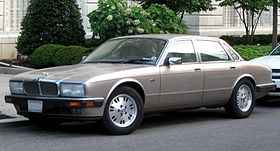Jaguar XJ40
| Jaguar XJ (XJ40) | |
|---|---|

Jaguar XJ6
|
|
| Overview | |
| Manufacturer | Jaguar Cars |
| Also called | Jaguar Sovereign |
| Production | 1986 – June 1994 |
| Assembly | Coventry, England |
| Body and chassis | |
| Class | Luxury vehicle (F) |
| Body style | 4-door sedan |
| Layout | FR layout |
| Powertrain | |
| Engine | 2.9 L AJ6 I6 3.2 L AJ6 I6 3.6 L AJ6 I6 4.0 L AJ6 I6 6.0 L Jaguar V12 |
| Transmission | 4-speed automatic ZF 4HP22 4-speed automatic ZF 4HP24 4-speed automatic GM 4L80-E 5-speed manual Getrag 265 / 290 |
| Dimensions | |
| Wheelbase | 113 in (2,900 mm) 118 in (3,000 mm) (Majestic) |
| Length | 196.4 in (4,990 mm) 201.4 in (5,120 mm) (Majestic) |
| Width | 70.9 in (1,800 mm) |
| Height | 54.25 in (1,378 mm) |
| Curb weight | 3,792 lb (1,720 kg) – 3,902 lb (1,770 kg) |
| Chronology | |
| Predecessor |
Jaguar XJ (Series I, II, and III) Jaguar XJ (Series I) Jaguar XJ (Series II) Jaguar XJ (Series III) |
| Successor | Jaguar XJ (X300) |
The Jaguar XJ (XJ40) is a luxury sedan manufactured by Jaguar Cars between 1986 and 1994. Officially unveiled on 8 October 1986 it was an all-new redesign of the XJ to replace the Series III, although the two model ranges were sold concurrently until the Series III was discontinued in 1992. The XJ40 used the Jaguar independent rear suspension arrangement, and featured a number of technological enhancements (such as electronic instrument cluster).
The 1993 XJ6 earned the title of "Safest Car in Britain" as the result of a government survey. When the XJ40 was discontinued in 1994, it was followed by the X300 platform XJ.
Throughout the 1970s Jaguar had been developing "Project XJ40", which was an all-new model intended to replace the original XJ6. Scale models were being built as early as 1972. Due to the 1973 oil crisis and problems at parent company British Leyland, the car was continually delayed. Proposals from both Jaguar's in-house designers and Pininfarina were received. Eventually, it was decided an internal design would be carried through to production and, in February 1981, the British Leyland board approved £80 million to produce the new car.
Jaguar historians claim that the XJ40 was the last car which company founder Sir William Lyons had contributed to during its protracted development phase. The previous generation XJ had been the final Jaguar to be developed wholly under Lyons' leadership - although he continued to take an active consultative role within Jaguar design, long after had retired from the day-to-day management of the firm following its merger in 1966 with the British Motor Corporation.
Designs for the XJ40 pioneered significant improvements to how Jaguar cars were designed, built, and assembled. Among these improvements was a 25 per cent reduction in the number of bodywork panels required per car (e.g. three pressings needed for a Series 3 door compared with one for a XJ40 door), resulting in not only a more efficient assembly process, but also a weight saving and a stiffer structure. Greater attention to panel gaps improved the drag factor (reduced from 0.849 Cd to 0.762 Cd), while also improving the fuel economy and lowering wind noise inside the cabin.
...
Wikipedia
